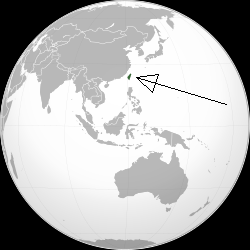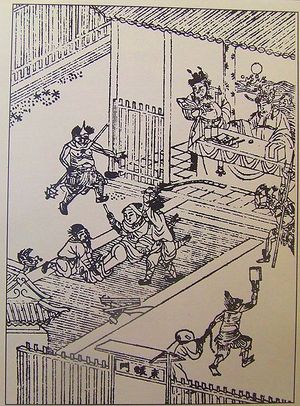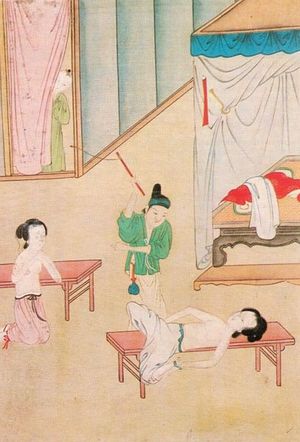Taiwan
| Taiwan |
|
|
Source information is available at [ Sources ] |
China is a cultural region, an ancient civilization, and a national or multinational entity in East Asia.
The modern political entity governing mainland China, Hong Kong and Macao is the People's Republic of China. The modern political entity governing Taiwan is the Republic of China.
With a population of over 1.3 billion, the People's Republic of China is the most populous country in the world. Its capital is Beijing, its largest city is Shanghai and its official language is Mandarin.
The Republic of China has a population of about 23 million. Its capital and largest city is Taipei. Its official language is Standard Mandarin (Guóyǔ).
Corporal punishment in China
In the 20th century, school corporal punishment fell out of fashion and was gradually banned in many countries, a trend that continues until the present day.
As of May 2008, Taiwan prohibits corporal punishment in schools.
In both mainland China and Taiwan, parents may legally use corporal punishment on their children. Culturally, people in the region generally believe a minimal amount of corporal punishment for their own children is appropriate and necessary. Thus such practice is tolerated by the society as a whole.
Spanking is known as 打"股 (da pigu) or 责打 in Chinese. Besides hand-spanking, paddling and caning, a popular punishment method in China is kneeling. In judicial corporal punishment, a spanking instrument that resembles an oversized wooden paddle (almost like a paddle for rowing a boat) was used in China (something similar was used in Korea too).
School corporal punishment has been banned in both the People's Republic of China and Taiwan, but it is still known to be practiced in some form in many areas.
Judicial corporal punishment, too, is today officially banned in both the People's Republic of China and Taiwan. The real situation may not always reflect the law, though. China generally does not have the best reputation for protecting human rights in its judicial system.
School corporal punishment in Taiwan
Corporate punishment had been widespread in Taiwanese educational institutions, with the government regulation against corporal punishment being largely ignored. The Humanistic Education Foundation has conducted a yearly poll that seeks to ascertain the extent of the percentage of students affected by corporal punishment in Taiwanese schools. The results indicate that, while a majority of students continue to be subject to corporal punishment, its use is slowly declining:
| 1999 | 2000 | 2001 | 2004 | 2005 |
|---|---|---|---|---|
| 83.4% | 74.2% | 70.9% | 69.4% | 65.1% |
| Source: Humanistic Education Foundation | ||||
A 2004 poll also found that corporal punishment was performed in 93.5% of schools.[1]
Despite being illegal since January 2007, a nationwide survey conducted in April and May 2007 found that 52.8% of students reported receiving corporal punishment, lower than in previous years but still constituting a majority. It appears, however, that the ban has brought about a change in the types of corporal punishment administered. Physical beatings or spankings of students declined from 51% in 2005 to 27.3% in 2007, accompanied by a rise in indirect forms of physical punishment, such as being forced to stand up for an extended period of time, which increased from 9.7% in 2005 to 35% in 2007.
School corporal punishment in Taiwan was banned in December 2006 through an amendment to the country's Fundamental Law of Education, with the ban coming into force in January 2007.
Film and television
Scenes of corporal punishment are frequently shown in Chinese films and television series. Sometimes in contemporary dramas depict a husband-wife spanking, the birching of a child, and even adults beaten with long wooden paddles or rods.
But the most severe punishments appear in lavish historical dramas about Feudal China. The majority of these films and shows are set during the opulent Ming Dynasty (16th century). Many of these tales of emperors, warlords, and royal concubines depict ancient domestic and judicial punishment forms.
This includes scenes of a double birching, beating with a bamboo pole, and the use of a large leather strap and specially designed wood paddles.
Chinese spanking art
There is little known spanking art from China. Chinese culture is traditionally quiet about matters of sexuality, so topics such as BDSM or erotic spanking are rarely openly discussed, even on the Internet.
Prostitution in Taiwan
- Prostitution in Taiwan ↗ on Wikipedia
See also
- China @ SM201 / China @ WP
- People's Republic of China @ WP
- Republic of China @ SM201 / Republic of China @ WP
- Corporal punishment in Taiwan @ WP
- Corporal_punishment_in_Taiwan @ WP
- Corporal punishment in Taiwan @ WP
External links
- 60% of Chinese children suffer corporal punishment (news article, 2004)
- Citizen Cane - translation of an article on corporal punishment in China by Xing Bao on World Corporal Punishment Research
- Photo of judicial punishment, c. 1900
- Punished for stealing, Wei Hai Wei flogging
Chat rooms • What links here • Copyright info • Contact information • Category:Root
- ↑ Spanking goes on in schools despite law, The China Post, 2 April 2004



